The Holy Land & Petra
The Tour Itinerary:
This morning we will drive to the Mt. of Olives for a panoramic city view of the “Golden City” of Jerusalem. We will visit the Church of Pater Noster (commemorating the Our Father) and the Chapel of the Ascension. We will then walk along the “Palm Sunday Road” to Dominus Flevit where Our Lord wept over Jerusalem. Continuing on to the Garden of Gethsemane, we will visit the Church of All Nations for Mass followed by a stop at the tomb of the Virgin Mary. We will then drive to Bethany where Our Lord would come to recuperate in the home of His loving friends, Mary, Martha, and Lazarus before setting out once more on His mission. After visiting the Tomb of Lazarus we will continue on to Jericho, the oldest known city in the Western World. From the top of the ancient “tel”, we’ll have an excellent view of Elisha’s Fountain, the Mt. of Temptation and the Sycamore tree to remind us of the story of Zaccheus, the tax collector. We will proceed to the Dead Sea for a swim in its salty, mineral laden waters before returning to Bethlehem.
We were told by three people from George's Tours that this morning's tour would begin at 8:00. Around 7:00, I learned that we were to depart at 7:30. As I was trying to alert the Hacheys to the time change, I learned that they had been informed of the new departure time so they and I were ready in time and even managed to wolf down a bit of breakfast.
We met our tour guide, Rami Salfiti, an Arab Christian who is a native of Jerusalem, and Fr. Jim Gardiner, our spiritual director who is a Franciscan based in Washington DC. I later learned that these tours are usually led by one person, a Franciscan who is very familiar with the Holy Land and acts as both guide and spiritual director. The priest that was supposed to do this had a schedule problem so Rami was brought on and Fr. Jim assigned as support. See below for a picture of Rami and Fr. Jim.
All 32 of us on the tour along with Fr. Jim and Rami piled onto a large and comfortable bus and took off on this day's adventures. We were given a prayer card and began with the prayer with which we were to begin every day:
>>>>> "Lord Jesus Christ, you were a pilgrim in the Holy Land. Now you lead and guide us on our pilgrimage to the heavenly Jerusalem. As we follow in your steps, we ask the grace to keep our eyes on you. Open our hearts that we may find you not in ancient
Day Four: Places Near Bethlehem
Thursday, November 10
The Tour Itinerary:
This morning we will drive to the Mt. of Olives for a panoramic city view of the “Golden City” of Jerusalem. We will visit the Church of Pater Noster (commemorating the Our Father) and the Chapel of the Ascension. We will then walk along the “Palm Sunday Road” to Dominus Flevit where Our Lord wept over Jerusalem. Continuing on to the Garden of Gethsemane, we will visit the Church of All Nations for Mass followed by a stop at the tomb of the Virgin Mary. We will then drive to Bethany where Our Lord would come to recuperate in the home of His loving friends, Mary, Martha, and Lazarus before setting out once more on His mission. After visiting the Tomb of Lazarus we will continue on to Jericho, the oldest known city in the Western World. From the top of the ancient “tel”, we’ll have an excellent view of Elisha’s Fountain, the Mt. of Temptation and the Sycamore tree to remind us of the story of Zaccheus, the tax collector. We will proceed to the Dead Sea for a swim in its salty, mineral laden waters before returning to Bethlehem.
We were told by three people from George's Tours that this morning's tour would begin at 8:00. Around 7:00, I learned that we were to depart at 7:30. As I was trying to alert the Hacheys to the time change, I learned that they had been informed of the new departure time so they and I were ready in time and even managed to wolf down a bit of breakfast.
We met our tour guide, Rami Salfiti, an Arab Christian who is a native of Jerusalem, and Fr. Jim Gardiner, our spiritual director who is a Franciscan based in Washington DC. I later learned that these tours are usually led by one person, a Franciscan who is very familiar with the Holy Land and acts as both guide and spiritual director. The priest that was supposed to do this had a schedule problem so Rami was brought on and Fr. Jim assigned as support. See below for a picture of Rami and Fr. Jim.
All 32 of us on the tour along with Fr. Jim and Rami piled onto a large and comfortable bus and took off on this day's adventures. We were given a prayer card and began with the prayer with which we were to begin every day:
>>>>> "Lord Jesus Christ, you were a pilgrim in the Holy Land. Now you lead and guide us on our pilgrimage to the heavenly Jerusalem. As we follow in your steps, we ask the grace to keep our eyes on you. Open our hearts that we may find you not in ancient
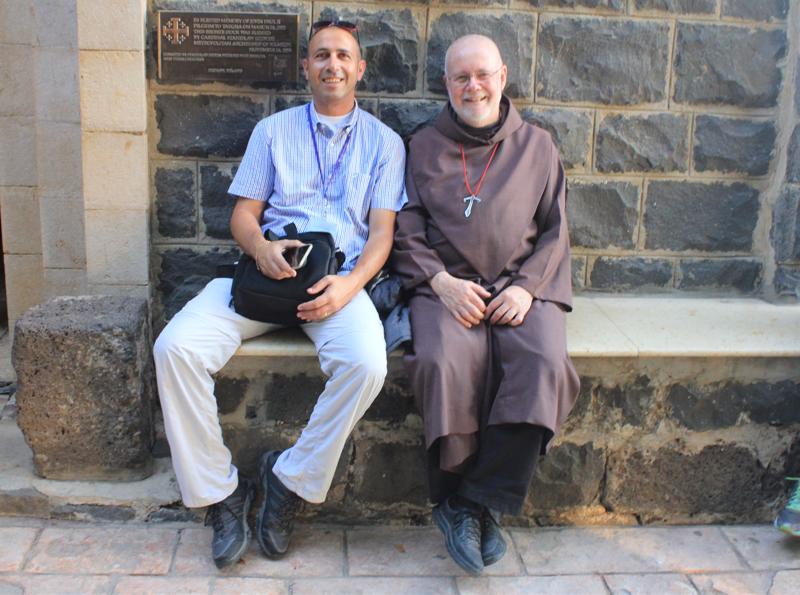
stones but in your people and each other. Let you words be a fire burning within us. Write your Gospel upon our hearts. Give us a spirit of prayer lest we return full of facts but not of grace and love. Lord, teach us to pray in the very land where you taught your disciples so the we may say: Our Father..."
As we drove from Bethlehem to the area near Jerusalem, Rami provided a history of the area since 1900. His account showed anti-Israeli bias, but, as I was to learn later, Israelis treat Christians and presumably Muslims as second class citizens in Israel so Rami's animus was understandable. We had some nice views of the Old City as we made our way to the Church of All Nations, which is also known as the Church or Basilica of the Agony. The church is built atop the stone on which Jesus prayed the night when He went through His agony in the Garden of Gethsemane. The church is small
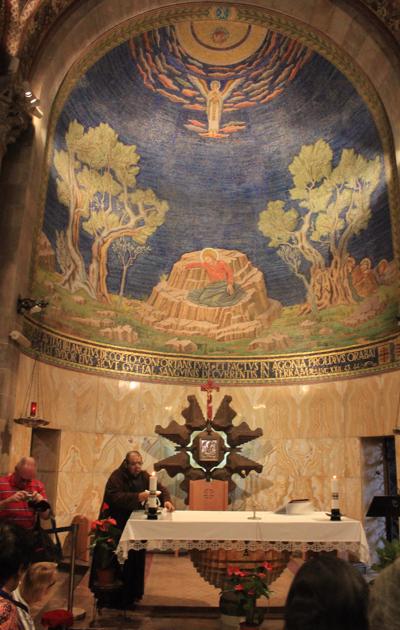
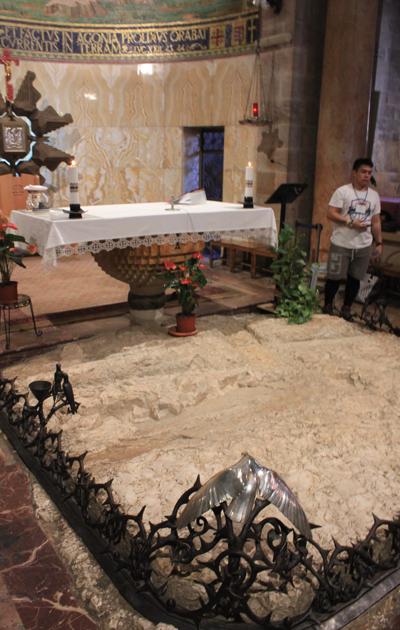
but very pretty. Directly in front of the altar is an exposed rock, and it is this rock on which Jesus was thought to pray (pictures top of prior page).
We celebrated Mass there as we did every day. The Mass readings are not the proscribed readings for the day but rather readings appropriate to the place where Mass is being celebrated. This day the Gospel told how Jesus took Peter, James and John and went to pray in the garden on the night before He died. Fr. Jim doesn't rush through the Mass but doesn't drag out the service. After the Gospel reading he gives maybe a two minute homily and then tells the assembly to take a minute to reflect on what they just heard and where they are.
The are multiple Christian sects in Israel: Roman Catholic, Greek Orthodox, Russian Orthodox, Syrian Orthodox, Syrian Catholic,
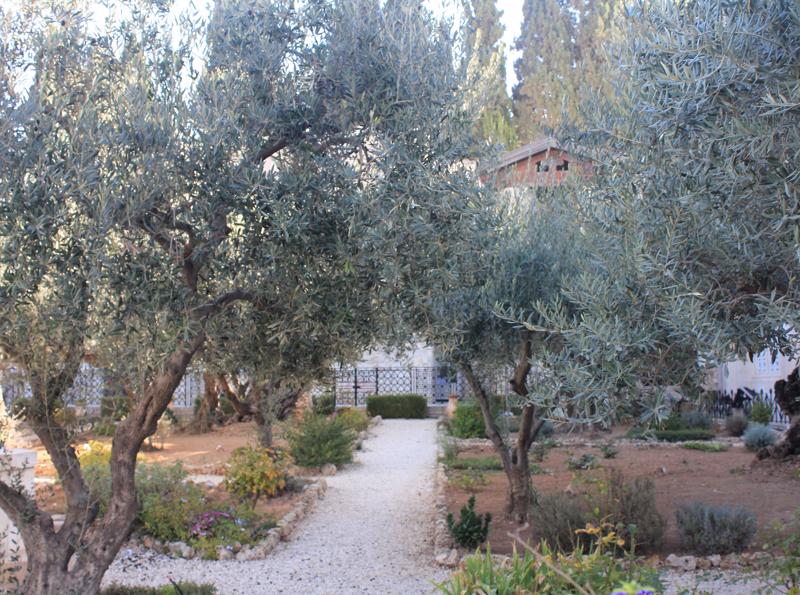
Armenian Catholic, Armenian Apostolic, Coptic, Chaldean (Iraqi Catholic), and so on.
All the sites we visited have an association with Jesus such as the rock described above. Of course, after 2,000 years, it is impossible to say with certainty that any site is exact. All the sites, however, have a similar lineage. There is usually some evidence that early 2nd and a few late 1st century Christians built small shrines on spots they thought had a significant connection with Christ. In 330, St. Helena, Emperor Constantine's mother, came to the Holy Land to locate these sites. When she did, she built large structures over them. In 614, Persians invaded Israel and destroyed many sites. In 636, Muslims invaded and destroyed everything the Persians missed. Around 1100, the Crusaders conquered the Holy Land and built large edifices on the ruins of earlier structures. When the Muslims again conquered Israel, the Crusader churches were torn down. Since 1852, the Christians were given permission to rebuild by the then Ottoman emperor. Many of the shrines and churches we visited have a couple of courses of foundation stones that date from the Crusader period. The are even a few inclusions from earlier shrines and churches. The sites themselves are classed as highly likely to unlikely although even
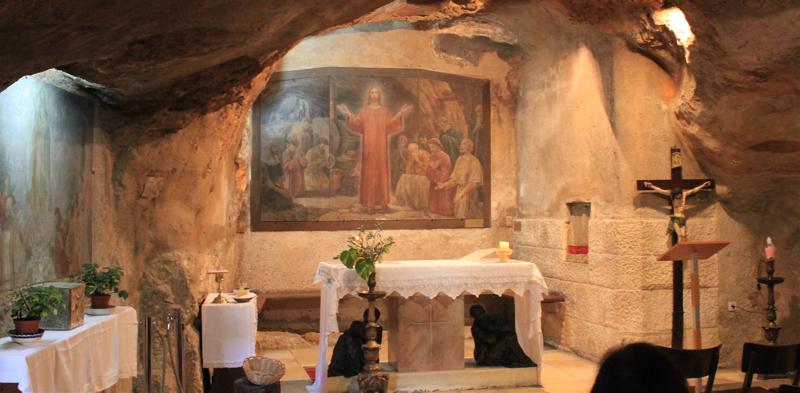
the unlikely sites are probably close to where Jesus walked.
While I knew that the Franciscans were responsible for many of the churches and shrines in the Holy Land, I didn't realize the impact. At each site we visited, we had a Mass time reserved for us because we were on a Franciscan tour. The Franciscans "own" (their descriptor) most of the key sites in the Holy Land. Greek Orthodox are the next biggest "owners". In the two shared churches we visited, the Church of the Nativity and the Church of the Holy Sepulcher, the Greeks own the most space followed by the Franciscans. Our access was amazing.
After Mass we walked past the Garden of Gethsemane (picture on page 16) which is adjacent to the Church of All Nations. It still has producing olive trees and one may date to the time of Christ. We next went to the Grotto of Betrayal which commemorates the spot where Judas did his dirty deed. The picture on page 17 shows the chapel within the grotto. We then boarded our bus which took us to the top of the Mount of Olives. Along the way we passed the Orthodox Church of the Dormition which is one of the two places where Mary may have died.
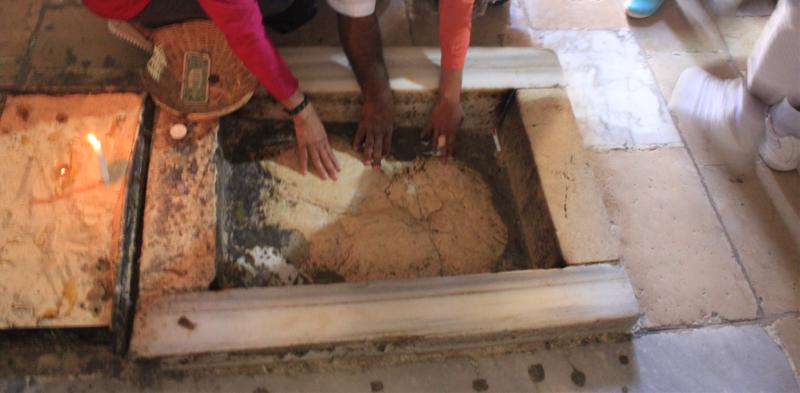
At the top of the Mount, we visited the Mosque of the Ascension. Yes, mosque. Muslims believe that Jesus was a major profit and that He ascended to heaven so they erected a tiny structure over the rock on which Jesus stood when He ascended (upper left picture above is the mosque, picture on the prior page is the rock where Jesus stood before He ascended). Next up was the Church of the Pater Noster where, it is believed, that Jesus taught the Apostles to pray. There are plaques in many languages with the Our Father both inside the church and around the perimeter of the church's courtyard (photo above right).
Walking down the mount, we stopped at the shrine called Dominus Flevit in Latin where Jesus wept over the expected destruction of Jerusalem. The shrine is on the eastern side of the Old City across the Kidron Valley, and the location affords spectacular views of the City
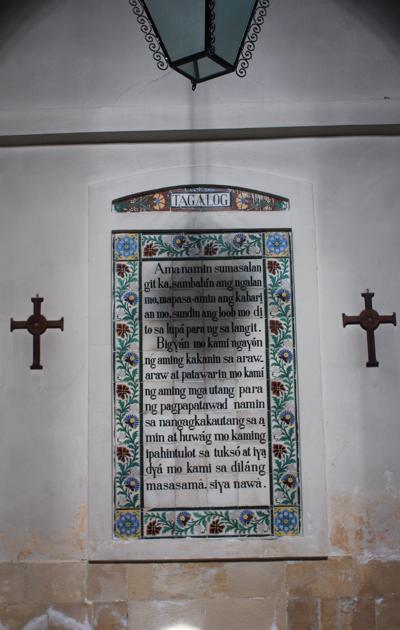
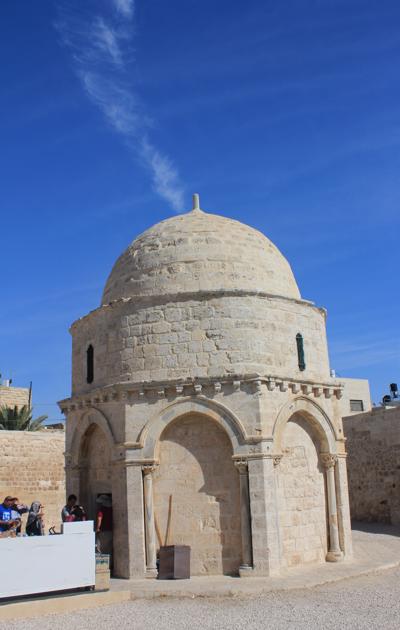
(picture below). Rami pointed out all the places where Jesus was starting with the Last Supper and ending with His Crucifixion. Jesus went from the Upper Room outside to the walls of Jerusalem across the Kidron Valley to the Garden of Gethsemane then was taken in chains to Caiaphas's house near the Upper Room then to Pilate at the Fortress of Antonio then the Via Dolorosa and Golgotha where He was crucified. The stops were closer to one another than I had imagined although the route did involve a lot of ups and downs. In the future when I read of Jesus's Passion and Death, I will always see this route in my mind.
After a buffet lunch at the Christmas Hotel in the Old City, we departed for Bethany where we saw Lazarus's tomb and the Church of St. Lazarus (pictures on facing page). We then boarded our bus for a long ride through the Judean desert to Jericho. The land is barren and, while some deserts can be pretty, this one was not. Along the
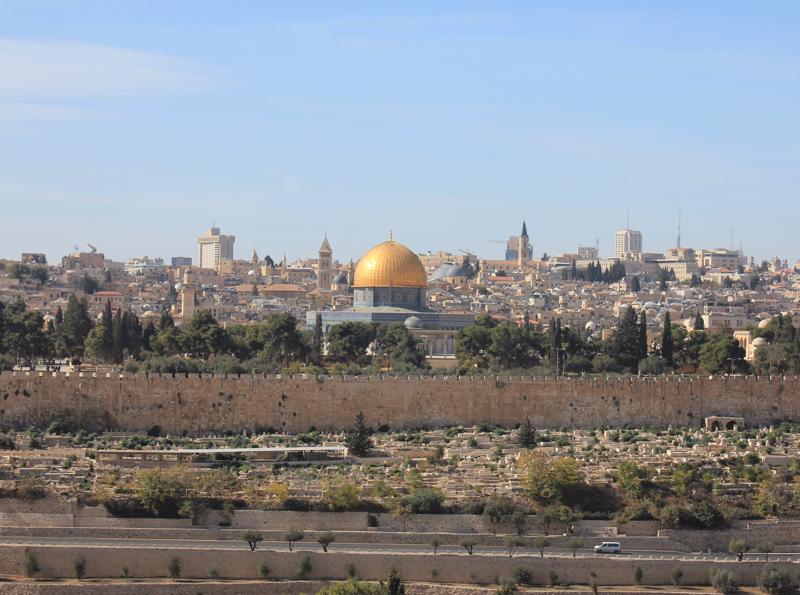
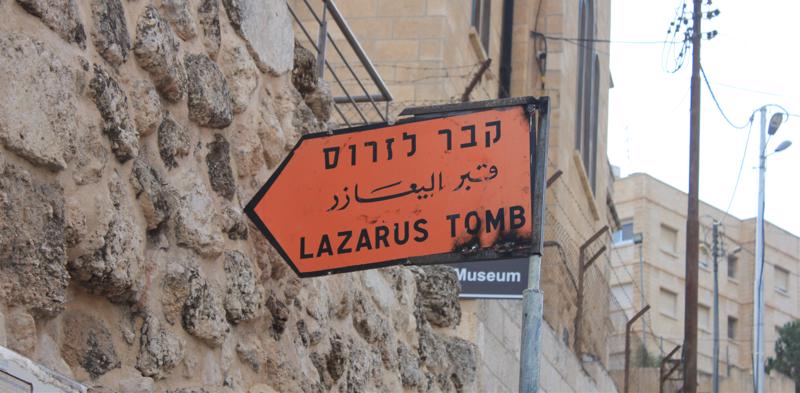
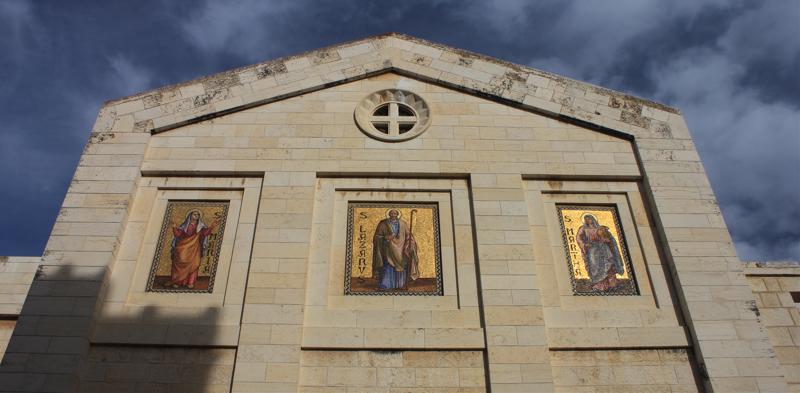
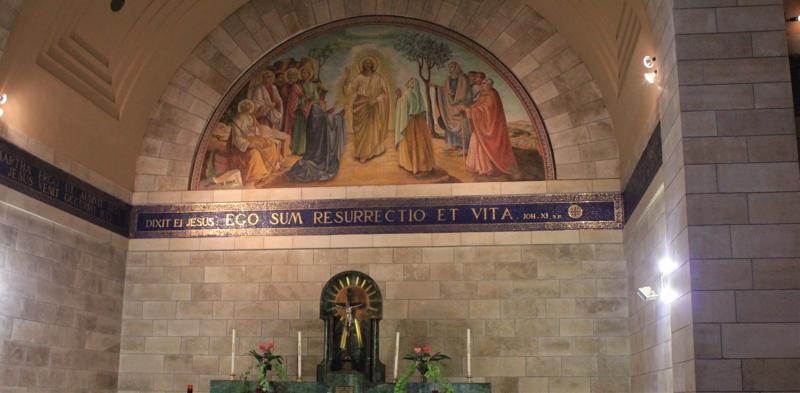
way we saw a couple of herders on donkeys with large flocks of sheep and goats. We also saw three or four Bedouin encampments with tents and shacks. However, all had a truck or SUV and one had a satellite dish.
We stopped on the outskirts of Jericho to see the Mount of Temptation and a badly excavated tel. In Jericho, a nondescript town, we saw a sycamore tree but not the one that Zaccheus climbed. We moved on to the Dead Sea which was close to Jericho. Although I had brought a bathing suit, I decided not to go in after hearing of the health perils if any of the water got into the eyes or mouth.
We returned to our hotel in Bethlehem and had another buffet dinner. The buffets are all very similar. They are large and feature numerous vegetable dishes in various sauces. There is not much meat or other things that I would more readily eat. I was feeling a little queasy after dinner.
Accommodations: Mount David Hotel
1.
Day One: Depart the USA
2.
Day Two: Arrive Tel Aviv & Bethlehem
3.
Day Three: Jerusalem
4.
Day Four: Places Near Bethlehem
5.
Day Five: Bethlehem
6.
Day Six: Jerusalem Again
7.
Day Seven: Jerusalem to Jordan & Petra
8.
Day Eight: Petra & Amman
9.
Day Nine: Amman to the Sea of Galilee
10.
Day Ten: Galilee
11.
Day Eleven: Tiberias to Tel Aviv
12.
Day Twelve: Return Home
13.
Post-Trip Reflections